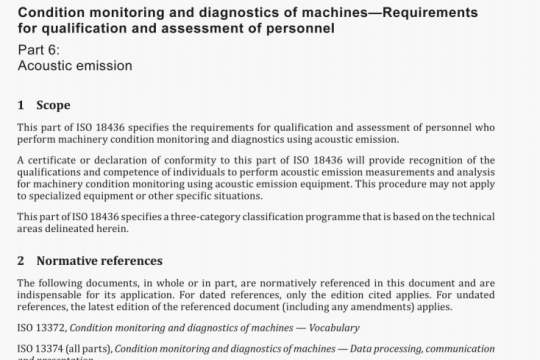ISO 2926:2013 pdf free
ISO 2926:2013 pdf free.Aluminium oxide used for the production of primary aluminium
Prepare the test sieves as follows.
a) Clean each test sieve (4.1) in turn by inverting it over a suitable container, brushing the mesh to remove trapped particles and tapping the sieve frame lightly to remove any adhering particles.
b) Inspect each sieve to ensure that the mesh is not ruptured and there is not excessive aperture binding. Upon holding the sieve up to a light source, areas of blinding are visible as being darker in appearance. If more than 10 % of the sieve mesh is blinded the sieve is not sufficiently clean to use.
Larger ruptures in the sieve may be seen by visual inspection. To see smaller ruptures magnification is required. Inspection using a stereo microscope is recommended; scan the entire mesh area and the edges to check for ruptures.
NOTE 1 Ruptures of the mesh can be successfully repaired using silver solder or hardening synthetic resin.
When a repair is performed, check the repaired area under magnification to ensure the rupture is covered and that the solder is bonded to the mesh.
NOTE2 Other options for cleaning sieves are given in Annex D.
Determine the size distribution as follows.
a) Weigh each sieve (masses m1) on the top pan balance (4.3) to the nearest 0,01 g. Similarly, weigh the bottom receiver.
b) Assemble the test sieves (4.1) on the mechanical sieve shaker (4.2) in order of increasing aperture size from bottom to top, starting with the bottom receiver.
c) Spread the test portion (5.1) on the top-most sieve. Close with the tightly fitting lid and install the positioning cover. Lower the hammer onto the cover.
The test program (see Annex C) was performed on four samples by seven laboratories using pre-mixing and splitting via rotary splitters. It showed that precision was partially sample dependant and thus an overall precision limit cannot be implied.The means, repeatability (r) and reproducibility (R) determined for each sample from the test program are given in Table 1.
The average precisions for the four samples are also given in Table 1. These averages are indicative of the precisions that can be expected from this method but users should also note the range of precisions possible for different samples as indicated by the results for the four individual test samples.ISO 2926 pdf download.




